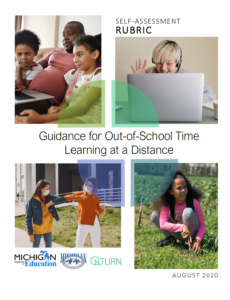Since the onset of the coronavirus pandemic, as schools grappled with the sudden demand for remote instruction, afterschool and other out-of-school time (OST) programs have been striving to adapt. As programs expand their remote offerings and gradually reopen, there is a need for guidance. Delivering the same high-quality supports to children and youth at home is a formidable challenge, and returning to in-person programming requires adjustment to a new normal. While the details of this new normal are still uncertain, one thing is clear. The coronavirus has not disappeared. Support for longer-term adaptations is needed.
In response, QTurn has released Guidance for Out-of-School Time Learning at a Distance (GOLD), a set of standards and indicators with a corresponding self-assessment rubric. The standards describe promising practices for afterschool learning at a distance that harmonize with existing standards and competencies. The rubric provides leaders with a means for assessing program readiness in order to provide responsive training and technical assistance. Funders and intermediary organizations may also use the standards and assessment to identify system-level supports for achieving high quality.
The GOLD helps program managers and staff adopt a new model for quality at the point-of-service, a point which shifted to the home learning environment and has only recently begun a slow, uneasy shift back. The goal is to help OST programs continue providing high-quality supports to children and families at a time when they are most needed.
Addressing New Pressures on Afterschool Programs
Like others around the world, the afterschool field entered uncharted territory this spring. When schools shut down, many programs closed completely. Some shifted their focus. For example, staff at ourBRIDGE for Kids in Charlotte, North Carolina, delivered packaged meals to school-age children. In other cities, afterschool counselors have connected with children online and offered tutoring, remote activities, and various social and emotional supports. Providers have faced novel demands stemming from family stress, barriers to virtual learning, and a difficult transition back to in-person learning.
Family Stress
Almost two-thirds of parents report shouting, yelling, or screaming at their children at least once in the past two weeks, according to a study by the University of Michigan. More than half say that financial concerns and social isolation have interfered with their parenting. Parents and caregivers have been under tremendous strain. The ubiquitous rise in stress prompted a response from the World Health Organization which released advice for families and a series of COVID-19 parenting posters.
Comments from parents in the University of Michigan study:
“I feel I’ve been somewhat distant even though I’ve been spending more time with the kids than ever.”
“They are confused. They don’t understand fully the dangers of a pandemic. They want to play with their friends and are getting annoyed with the same routine at home, and playing only with each other. We are also rationing food and household items, and they are anxious and scared by that. I can see it in their faces and their volunteering to make sacrifices for us.”
Like afterschool providers, they’ve raced to learn how to keep their children safe and engaged.
On recommendations for staying safe, one afterschool provider said, “Some of our parents can watch it on the news and not understand a word of it. Some of out parents don’t read real well, so if they read about it, they are not understanding it. They need someone to be able to explain to them maybe in different terms. So where it’s understandable for them and explain it to the kids at home.”
Barriers to Virtual Learning
Adding to this stress, not all children have had access to the technology needed to participate in virtual programming. The home learning environment varies considerably from one household to another, exacerbating the digital divide and presenting hurdles to equity. Even if the child has access to a smartphone, the phone may belong to a parent, or they may be competing with other siblings for screentime. Some children also lack the basic materials, like blank paper or corn starch, necessary for engaging in hands-on expanded learning activities at home.
“I mean, it’s all over the map. Some are using phones if they don’t have a phone, some are using Chromebooks. I know the school did offer the Chromebooks to people but from my experience, so for whatever reason Zoom does not agree with Chromebooks very well. It’s not real fluid. I just I’ve talked to the parents. And they have internet but their connection isn’t fast enough to support Zoom, which is entirely possible. And I’ve had kids get on and then their phones died because Zoom just eats up a whole battery.”
From the program side, converting lessons designed for in-person programming into engaging, remote learning is a daunting task under ordinary circumstances. In a field that emphasizes cooperative learning and group activities, social distancing may seem like the antithesis of the afterschool experience.
“Because you’re just showing your head on the zoom. Sometimes you can’t really tell what is going on. Or if they are having other issues, and sometimes on zoom, they aren’t going to talk to you about it. But, if you were at school, they would say ‘hey we need to talk’ or you can pull them aside and ask them what’s going on. I think it’s just that that sometimes not physically being able to see their bodies, their body reactions how they react to questions. You don’t see them if you’re being there in person.”
Promoting social and emotional learning in the absence of in-person interactions requires some creative solutions. In the midst of an ongoing crisis, children need the support of caring adults more than ever.
“I have one little girl who will call me every day, and I pick up, because what else am I doing. And she’ll tell me about the bird she saw on the walk, or a drawing she did, or a video. And she just loves to check in and say hi and then I see her on the zoom calls too.”
The Road Back
When children do return to programs in person, the need for new safety measures, policies, and practices have resulted in a rough road back. Due to rising infection rates, schools are considering the possibility of reopening with a hybrid model that combines in-person and remote learning.
“Simply re-creating the pre-shutdown norm will be neither possible nor desirable.”
– Erika Christakis, For Schools, the List of Obstacles Grows and Grows, The Atlantic
Sustaining Positive Outcomes for Children and Youth
Under ordinary circumstances, to have positive social, emotional, and academic benefits for children and youth, afterschool programs must be of high quality. Lower-quality programs generally do not lead to positive outcomes. For this reason, quality standards have been a guide for programs across the country since 1998 when the National Afterschool Association developed the Standards for Quality School-Age Care. States have continued to adopt and improve quality standards to meet changing needs in their communities.
Existing standards cover safety and health, relationships, youth engagement, equity, and access. While rooted in principles of positive youth development that apply no matter where learning takes place, existing standards developed for in-person programming do not immediately translate to distance learning. Existing standards illustrate what high-quality afterschool learning looks like… under ordinary circumstances.
But what does quality afterschool learning at a distance look like? Knowing the importance of high quality for supporting youth development, can high quality continue during a nationwide quarantine and transition back to in-person services? How has the role of afterschool staff changed? How can programs adapt?
To answer these questions, the Genesee Intermediate School District (GISD) Bridges to Success team partnered with QTurn. Led by Charles Smith, an expert on afterschool quality with more than 20 years of experience in the field, QTurn interviewed 15 afterschool staff from nine sites as well as an administrator from the GISD office. Throughout each step of the development process, expert practitioners provided extensive input and feedback.
Summary of the Guidance
Guidance for Out-od-School Time Learning at a Distance addresses social, emotional, and academic learning and takes a whole-child approach. It includes 10 standards and 27 indicators. The self-assessment can be completed in less than two hours.
QTurn identified four domains of quality for OST programming at a distance. The 10 quality standards fall into these domains, which address the new pressures on afterschool programs to connect with children and provide content in new environments.

- Family- and Caregiver-Centered Engagement
- Individual Learning Environment
- Distance Programming
- Planning with Children, Families, Caregivers, and Schools
The first domain, Family- and Caregiver-Centered Engagement, outlines new roles for afterschool staff as advocates and resources for families. In addition to helping families and caregivers understand critical information for thriving in quarantine, a trauma-informed, strengths-based approach to family engagement is recommended.
The second domain, Individual Learning Environment, addresses barriers to virtual learning. Programs are encouraged to use a variety of methods, technologies, times, and languages to connect with families. Supporting virtual learning means helping families create a workspace for children, equipping students with educational supplies, and coaching families on the use of key technologies or apps.
The third domain, Distance Programming, identifies strategies for continued social and emotional learning (SEL) despite the disconnect inherent in video conferencing. Practices that support staff wellness also contribute to their ability to model SEL skills for children and complete social and emotional check-ins. Included in this domain is an emphasis on school-day alignment, collaborative leadership, and partnerships between program and school day staff.
Finally, Guidance offers support for the transition back to in-person learning through the fourth domain, Planning with Children, Families, Caregivers, and Schools. Planning must include strategies for following social distancing guidelines as well as social and emotional supports for students’ well-being as they resume learning.
The rubric, which corresponds to the standards and indicators encompassed by the above domains, provides programs with the means to assess readiness. After completing the self-assessment, program staff are encouraged to decide which indicators to focus on and set action steps for improving practice or updating policy.
Coming Back Stronger
Afterschool programs and intermediary organizations have endured a period of intense uncertainty around the future of afterschool. Programs throughout the country are in different stages of reopening, but shutdowns have left a permanent mark on the afterschool field. Having witnessed the widespread interruption of a whole sector of youth services, many afterschool programs and staff may never fully return to “business as usual.”
The upheaval of the past few months, however, presents opportunities to build resilience within the field. When children and youth are most in need of the supports unique to afterschool, programs will be equipped to respond.




